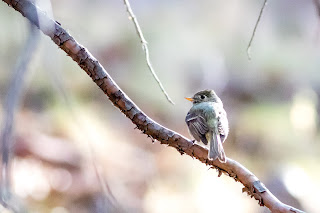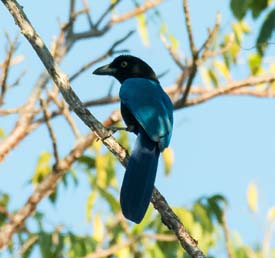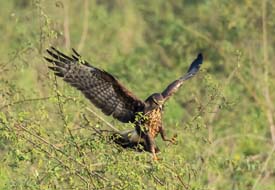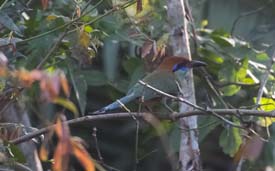We flew into Salt Lake City on Tuesday the 9th, and made the 220 mile drive west to Elko, NV. After an early dinner we drove another 20 miles up to the small town of Lamoille to check into Hotel Lamoille--a nice 3 room place that would shorten our drive at 4 AM the next morning up to the end of the road in Lamoille Canyon. Since there was some daylight left, we went up to Pump House picnic area to look for Lewis's woodpeckers which we found. Even more intriguing for me was the hummingbird moths that were actively feeding on flower nectar.
You have 2 choices when it comes to looking for the snowcock. Either you can hike up late in the afternoon, and spend the night at Island Lake so you are ready to start searching at first light; or begin hiking up in the dark to arrive soon after first light. In 2010 when I did my big year I hiked up and spent the night in early July, but failed to either see or hear a snowcock. I tried again in August camping out overnight that time with my friend Rob Lowry. We heard snowcocks calling, but we were unable to locate them in the vast area of the cirque. So besides helping Laura, I also wanted to finally see a snowcock, thus removing the only "heard only bird" on my ABA life list.
Our group decided that hiking up in the dark was preferred. The trail is very well maintained and includes many switchbacks, so hiking with a headlamp is not difficult. Since it was 47 degrees when we set out at 4:45 AM, it also was very comfortable hiking compared to my late afternoon hikes in 2010 when the sun was pounding down on me and the temp was in the 80's. As we were about to start up the trail, John Weigel, who is also doing a full ABA area big year, drove up and said he would catch up with us.
Each of us walked at our own pace in climbing about 1000 feet of elevation which meant we reached the lake at different times. Soon after Marty, Bert and I arrived at the lake John caught up with us. The 4 of us then hiked up another 200-300 yards to a level spot, and just after 6 AM began searching for the snowcocks.
We knew that a few had been seen regularly in the cirque over the past few weeks, so we figured we would be able to find them. While the scopes were being assembled, I was scanning in the most likely area of the cirque when I noticed some movement at an estimated distance of 200-300 yards. Looking through 2 scopes we located at least 4 snowcocks, which are the size of a small turkey, slowly feeding on seed heads. They can be very difficult to find if they are not moving because their color is so similar to the rocks.
Laura and Doreene had not arrived yet, so John walked back down the hill a bit to find them working their way up the steep incline. First Laura got to the scopes, and a few minutes later Doreene joined us. John had already seen a flying snowcock in late July, but had returned to get photos. As a result, he headed back down the mountain sooner than we did. Before he left, he took a "record" shot of the 5 of us, and we also got one of him and Laura.
The rest of us were able to spend an hour overall watching the snowcocks feed. We also saw other birds in the cirque and on our way back down including mountain bluebird, Townsend's solitaire, white-crowned sparrow, pine siskin, junco, rock wren, Cassin's finch, MacGillivray's and Wilson's warblers, western wood pewee, northern flicker, kestrel and red-tailed hawk.
Since we were so successful in finding the snowcocks, it meant we could now drive back to Salt Lake City instead of needing to try again the next day. Enroute we stopped in some good habitat for juniper titmouse--a bird that Laura still needed for her big year list. We came up short, but early the next morning south of Salt Lake City we finally tracked down a couple.
Then we drove up to Bear River Migratory Bird Refuge which is about an hour north of Salt Lake City. We stopped on the way in Ogden for an early lunch at In-N-Out Burger which provided the "fuel" we needed to spend almost 4 hours birding the refuge.
There were 1000's of coots and many juveniles with which most of us were not familiar. We finally found some large pools of water that had a few waders like western and Baird's sandpiper, killdeer, and lesser yellowlegs.
Near the end of the drive we happened upon a huge group of long-billed dowitchers. It is hard to accurately estimate such a large number, but it was easily the most at one spot that I had encountered. We concluded that the total was between 4,000 and 5,000 birds. The photo below only captures some of the flock.
We still had time to make one more stop at Antelope Island SP where many birders go to see their first chukar. The great Salt Lake is very low this year, so the water did not come close to the long causeway drive out to the island except where the road crossed a small connecting point. We found 1000's of Wilson phalaropes there, and a few bank swallows sitting on a wire. In 2010 when I came to the island to see a chukar, the water was up to the causeway, and 1000's of eared grebes were feeding. On Thursday there were only a few of them.
We stopped at the visitor center to enquire about recent chukar sightings. We were told to just look behind the center, and sure enough we found a few of them moving in and out of the vegetation. Sometimes you have to work very hard to see a chukar, so we figured it was a perfect bookend to our earlier success with the snowcocks.
Early on Friday Marty caught a flight home, and Laura took a flight to Dallas to search for buff-breasted sandpipers. Bert, Doreene and I went up into Big Cottonwood Canyon to see what we could find. It was only 45 degrees when we started birding before 7 AM, so the birds were not very active. Over the next 3+ hours we did see some new trip birds like red-breasted nuthatch, mountain chickadee, sharp-shinned hawk, orange-crowned warbler, Lincoln's sparrow, and stellar's jay. We stopped on our way down the mountain to have breakfast, and were treated to 4 different kinds of hummers feeding at the lodge's feeders--broad-tailed, black-chinned, rufous and calliope. It was a very nice end to our birding trip which included over 100 bird species in just 2+ days of birding.
I want to close this post with a short update on how the big year birders are progressing. As I said in early July, this is proving to be a record breaking year for full ABA area big year birders. As of today, both John Weigel and Olaf Danielson have broken the record of 749 set in 2013 by Neil Hayward. John is at 756 species plus 2 provisionals (first ABA area record birds that will need to be reviewed, and hopefully added to the official ABA list). Olaf is at 752 plus 1 provisional. Also, Laura Keene has now reached a total of 714 + 2, and Christian Hagenlocher is at 711 + 2. No other big year has had 4 people break 700 different species. Both Laura and Christian might also pass the old record by the end of December, and John and Olaf will add even more birds to their respective totals before year end. Good fortune and birding to all of them.











































































